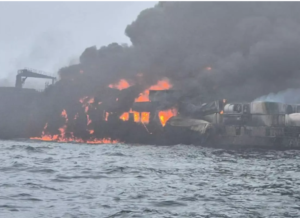The collision between an oil tanker and a cargo ship, resulting in a fire and subsequent oil spill, poses significant environmental threats. Such incidents can lead to extensive ecological damage, impacting marine life, coastal ecosystems, and human health.
Immediate Environmental Impacts
-
Oil Spill Contamination: The release of oil into marine environments can cause widespread contamination. Oil spills coat the surface of the water, leading to the suffocation of marine organisms and the destruction of insulating properties in mammals and birds, which can result in hypothermia. The toxic components of oil can also be ingested by marine life, leading to poisoning and disruptions in reproductive cycles.
-
Air Pollution from Fires: The combustion of oil releases harmful pollutants into the atmosphere, including sulfur oxides, nitrogen oxides, and particulate matter. These emissions can degrade air quality, posing health risks to nearby populations and contributing to atmospheric pollution.
Long-Term Environmental Consequences
-
Ecosystem Disruption: Oil spills can have prolonged effects on marine ecosystems. Habitats such as coral reefs, mangroves, and seagrass beds are particularly vulnerable. The degradation of these habitats can lead to a loss of biodiversity and the collapse of local fisheries, affecting both the environment and the livelihoods dependent on these resources.
-
Bioaccumulation of Toxins: The persistent components of oil can accumulate in the tissues of marine organisms, leading to bioaccumulation. Predators consuming contaminated prey can suffer from increased toxin levels, which may result in reproductive failures, growth defects, and increased mortality rates.
Case Study: East China Sea Oil Tanker Disaster
The 2018 collision of the oil tanker Sanchi in the East China Sea serves as a pertinent example. The tanker, carrying 136,000 tons of condensate oil, burned for over a week before sinking. The incident resulted in extensive environmental damage, including air pollution from the fire and marine contamination from the oil spill. The area affected was rich in marine life, including various species of fish, shellfish, and marine mammals, all of which were threatened by the spill.
Mitigation and Response Strategies
-
Rapid Response and Containment: Immediate action is crucial to contain the spill and minimize environmental damage. Deploying booms and skimmers can help contain and recover spilled oil, while dispersants may be used to break down oil slicks, although their environmental impact must be carefully considered.
-
Environmental Monitoring: Continuous monitoring of air and water quality is essential to assess the extent of pollution and its impact on marine and coastal ecosystems. This data informs cleanup efforts and helps evaluate the recovery of affected environments.
-
Wildlife Rehabilitation: Specialized teams are needed to rescue and rehabilitate affected wildlife. This includes cleaning oil-coated animals and providing medical care to improve their chances of survival and eventual release back into their natural habitats.
Preventative Measures
-
Enhanced Navigation Systems: Implementing advanced navigation technologies and strict adherence to maritime safety protocols can reduce the risk of collisions. Regular training and assessments ensure that crew members are prepared to handle potential hazards.
-
Stricter Regulations and Enforcement: Governments and international bodies must enforce stringent regulations on ship construction, maintenance, and operation to prevent accidents. Regular inspections and penalties for non-compliance can serve as effective deterrents.
-
Emergency Preparedness: Developing comprehensive emergency response plans, including regular drills and coordination among relevant agencies, ensures a swift and effective reaction to maritime accidents.
In conclusion, the environmental impact of an oil tanker bursting into flames after colliding with a cargo ship is profound and multifaceted. It necessitates immediate response efforts to mitigate damage and long-term strategies to prevent future occurrences. Learning from past incidents, such as the East China Sea disaster, underscores the importance of preparedness, robust regulations, and international cooperation in safeguarding marine environments.


